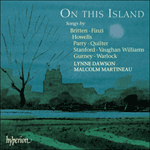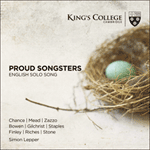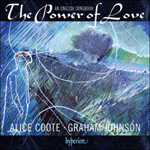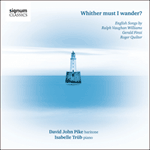
Welcome to Hyperion Records, a British classical label devoted to presenting high-quality recordings of music of all styles and from all periods from the twelfth century to the twenty-first.
Hyperion offers both CDs, and downloads in a number of formats. The site is also available in several languages.
Please use the dropdown buttons to set your preferred options, or use the checkbox to accept the defaults.

 PERFORMANCE
PERFORMANCE RECORDING
RECORDING

‘Silent noon’ offers relatively little contrast with the opening song except in tonality, but deploys a greater independence and melodic authenticity of vocal line. ‘Love’s minstrels’ alternates yet more of the textures from the previous two songs with free recitative-like passages, its piano-writing strongly suggesting a draft sketch for an orchestral arrangement. It hints immediately at the dense chordal opening texture of the Five Mystical Songs of 1911, but also at the ‘false-relation’ technique (juxtaposing ordinary triad chords such that one, two or three notes within them fruitfully ‘disagree’ with the content of the chord following) which was to emerge more fully in the string masterpiece Fantasia on a theme by Thomas Tallis (1910, revised in 1913 and 1919). The sense of an orchestra waiting in the wings recurs in the chordal formations of the remaining numbers: notably the fanfare figures of ‘Death in Love’ and the more serene harmonic agglomerations of ‘Love’s last gift’, whose opening fleetingly prefigures the composer’s oft-heard short motet O taste and see (1952, sung at RVW’s funeral in 1958) or his Sine nomine tune for the hymn ‘For all the saints’.
RVW was by no means alone in turning to France for inspiration and enlightenment. The early music of Frank Bridge reveals an indebtedness to the craft, manner and harmonic flexibility of Fauré’s early chamber works, while E J Moeran’s first orchestral rhapsody contains a central allegro powerfully influenced by Ravel; similarly, salient moments of John Ireland’s cello sonata proclaim Debussy, and the current revival of interest in York Bowen has revealed his keen contemporaneous awareness of Debussy’s keyboard-writing. Although this indicates how the supposed cul de sac of nineteenth-century Germanic academicism is only a part of the story of British music in the early years of the century following, it does also highlight the danger of merely exchanging one form of import for another. Meanwhile, in a world destined to change utterly in the face of the First World War, folk-song collectors such as Cecil Sharp were rescuing an indigenous British heritage at risk of vanishing for ever. In his essay ‘The evolution of the folk-song’, RVW later wrote that:
The folk-song is I believe not dead, but the art of the folk-singer is. We cannot, and would not if we could, sing folk-songs in the same way and in the same circumstances in which they used to be sung. If the revival of folk-song meant merely an attempt to galvanize into life a dead past, there would be little to be said for it. The folk-song has now taken its place side by side with the classical songs of Schubert … Is not folk-song the bond of union where all our musical tastes can meet? … And where can we look for a surer proof that our art is living than in that music which has for generations voiced the spiritual longings of our race?
Herein lay the seeds of what blanket terminology has dubbed ‘The English Renaissance’: the birth of a nationalist vein of composition in which the modal harmony implicit in the contours of English folk song mapped naturally onto what was similarly implied by ancient plainchant, the origin of medieval choral polyphony. The confluence of these elements is central to the development of RVW’s language beyond The house of Life, and also to what we might call the spiritual dimension of his subsequent output as a whole. It meant that the living pulse of an indigenous recent and distant past beat just as strongly in works which by their nature might seem to borrow genuine folk melody but which were actually free extensions that simply ‘spoke its language’. RVW’s folk-song arrangements were therefore no mere appendix to his ‘real’ output, but intrinsic components of it.
from notes by Francis Pott © 2022
 On this Island On this Island‘A top British soprano shines in a recital that should appeal well beyond her shores. The programme is delightful, and so are the performances’ (Gramo ... ‘The programme is well chosen, with familiar songs alongside some that have been unjustly neglected. Dawson’s performances are wholly intelligent, ni ...» More |
 Proud Songsters Proud SongstersThe English song tradition of the twentieth century is a glorious one, and never more so than when in the hands of such superlative musicians as we find here. Several new additions to the repertoire sit alongside favourites by Quilter, Finzi, Brit ...» More |
 The Power of Love The Power of LoveThe eagerly awaited Hyperion debut of Alice Coote, one of the most distinctive mezzos of her generation, who together with the indefatigable Graham Johnson explores love in its many manifestations in a pageant of English song and poetry that inclu ...» More |
 Vaughan Williams, Finzi & Quilter: Whither must I wander? & other songs Vaughan Williams, Finzi & Quilter: Whither must I wander? & other songsCentred around Vaughan Williams' Songs of Travel, this collection of English song—brilliantly interpreted by baritone David John Pike—brings together three now influential figures in the world of British music, namely Vaughan Williams, Roger Quilt ...» More |

